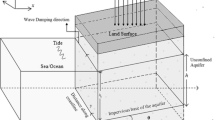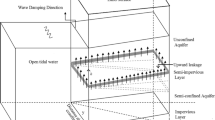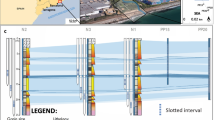Abstract
While in constant head aquifer, groundwater level before pumping and after recovery attain a constant value, it is quite challenging to estimate the actual discharge value in an atoll aquifer where the head fluctuates with tides. Lens shaped atoll aquifers are fragile in nature and pumping causes the water table to fall which could further aggravate sea water intrusion. Thus the objective of the study is to propose an alternative method and demonstrate the importance of tide-induced head fluctuations in analysing the aquifer parameter in atoll environment. The solution to a one-dimensional unsteady groundwater flow model in an atoll aquifer with sinusoidal fluctuations of the tide shows that the tidal response method (TRM) is reliable and safe in comparison to conventional methods of aquifer characterization. The aquifer parameter is described by the ratio of transmissivity to storage coefficient, known as hydraulic diffusivity. The observations of the tide and groundwater levels using loggers at 16 wells over the Kalpeni Atoll, Lakshadweep, India show that with distance from the coast, tidal efficiency decreases roughly exponentially and time lag increases linearly. The calculated hydraulic diffusivity (T/S) values using TRM range from 764 to 1,090,000 m2/day. In parallel, pumping tests are conducted in six shallow dug wells to validate the TRM data. Draw down and recovery data during pumping test are influenced by the tide-induced head fluctuations. The effect complicates the interpretation of the drawdown data. After subtracting the net tidal effects from the draw down data, the calculated parameter values are observed to be closer to the estimated parameter values from TRM.






Similar content being viewed by others
References
Alcolea A, Castro E, Barbieri M, Carrera J, Bea S (2007) Inverse modeling of coastal aquifers using tidal response and hydraulic tests. Ground Water 45(6):711–722
Aziz ARA, Wong KFV (1992) A neural- network approach to the determination of aquifer parameters. Ground Water 30(2):164–166
Balkhair KS (2002) Aquifer parameters determination for large diameter wells using neural network approach. J Hydrol 265(1–4):118–128
Banerjee P, Sarwade D, Singh VS (2008) Characterization of an island aquifer from tidal response. Environ Geol 55(4):901–906
Banerjee P, Singh VS, Chatttopadhyay K, Chandra PC, Singh B (2011) Artificial neural network model as a potential alternative for groundwater salinity forecasting. J Hydrol 398(3):212–220
Banerjee P, Singh VS, Singh A, Prasad RK, Rangarajan R (2012) Hydro-chemical analysis to evaluate the seawater ingress in a small coral island of India. Environ Monit Assess 184(6):3929–3942
Barlow PM, Masterson JP, Walter DA (1996) Hydrogeology and analysis of ground-water-flow system, Sagamoremarsh area, Southeastern Massachusetts. USGS Water-Resour Investig Rep 96:4200
Bobba A, Jeffries D, Singh V (1999) Sensitivity of hydrological variables in the Northeast Pond River Watershed, Newfoundland, Canada, due to atmospheric change. Water Resour Manag 13(3):171–188
Carotenuto L, Di Pillo G, Raiconi G, Troisi S (1980) Mathematical modeling and parameter identification for a coastal aquifer. Adv Water Resour 3:151–157
Carr PA (1969) Salt water intrusion in Prince Edward Island. Can J Earth Sci 6(1):63–74
Carr PA, Kamp VD (1969) Determining aquifer characteristics by the tidal method. Water Resour Res 5(5):1023–1031
Chang SW, Clement TP, Simpson MJ, Lee KK (2011) Does sea-level rise have an impact on saltwater intrusion? Adv Water Resour 34:1283–1291
Chapuis RP, Belanger C, Djaouida C (2006) Pumping test in a confined aquifer under tidal influence. Ground Water 44(2):300–305
Chattopadhyay Pallavi B, Singh VS (2013) Hydrochemical evidences: vulnerability of atoll aquifers in Western Indian Ocean to climate change. Global Planet Chang 106:123–140
Chen CS, Chang CC (2002) Use of cumulative volume of constant-head injection test to estimate aquifer parameters with skin effects: field experiment and data. Water Resour Res 38(5):141–146
Chen CS, Chang CC (2003) Well hydraulics theory and data analysis of the constant head test in an unconfined aquifer with the skin effect. Water Resour Res 39(5):SBH7-1–SBH7-15
Chen C, Jiao JJ (1999) Numerical simulation of pumping tests in multilayer wells with non-Darcian flow in the wellbore. Ground Water 37(3):465–474
Cirpka OA, Attinger S (2003) Effective dispersion in heterogeneous media under random transient flow conditions. Water Resour Res 39:1257. doi:10.1029/2002WR001931, 9
Dentz M, Carrera J (2005) Effective solute transport in temporally fluctuating flow through heterogeneous media. Water Resour Res 41:W08414. doi:10.1029/2004WR003571
Erskine AD (1991) The effect of tidal fluctuation on a coastal aquifer in the UK. Ground Water 29(4):556–562
Ferreira da Silva JF, Haie N (2007) Optimal locations of groundwater extractions in coastal aquifers. Water Resour Manag 21(8):1299–1311
Ferris JG (1951) Cyclic fluctuations of water level as a basis for determining aquifer transmissibility. Int Assoc Sci Hydrol 33:148–155
Fkir Y, Razack M (2003) Hydrodynamic characterization of a Sahelian coastal aquifer using the ocean tide effect (Dridrate Aquifer, Morocco). Hydrol Sci J 48(3):441–454
Hantush MS (1956) Analysis of data from pumping tests in leaky aquifers. Trans Am Geophys Union 37(6):702–714
Jacob CE (1940) On the flow of water in an elastic artesian aquifer. Trans Am Geophys Union 21:574–586
Jacob CE (1950) Flow of groundwater, in engineering hydraulics. Wiley, New York, pp 321–386
Jeng DS, Barry DA (2002) Analytical solution for tidal propagation in a coupled semi- confined/phreatic coastal aquifer. Adv Water Resour 25(5):577–584
Jhan MK, Kamii Y, Chikamori K (2003) On the estimation of phreatic aquifer parameters by the tidal response technique. Water Resour Manag 17(1):69–88
Knight JH (1981) Steady period flow through a rectangular dam. Water Resour Res 17(4):1222–1224
Kruseman GP, de Ridder NA (1994) Analysis and evaluation of pumping test data, 2nd ed. Publication 47. International Institute for Land Reclamation and Improvement, Wageningen
Li H, Jiao JJ (2001) Analytical studies of groundwater-head fluctuation in a coastal confined aquifer overlain by a leaky layer with storage. Adv Water Resour 24(5):565–573
Li H, Jiao JJ (2002) Analytical solutions of tidal groundwater flow in coastal two-aquifer system. Adv Water Resour 25(4):417–426
Lia H, Jiao JJ (2003) Tide-induced seawater–groundwater circulation in a multi-layered coastal leaky aquifer system. J Hydrol 274:211–224
Mallik TK (2001) Some geological aspects of the Lakshadweep atolls. Arab Sea Geol Surv India Spec Publ 56:1–8
Mannadiar NS (1977) Gozetteer of India – Lakshadweep. Government of India Press, Coimbatore
Nazeeb KM (1995) Groundwater resources and management in the Union Territory of Lakshadweep, Part II: Andrott and Minicoy Island, CGWB Report, Kerla Region 43
Nielsen P (1990) Tidal dynamics of the water table in beaches. Water Resour Res 26(9):2127–2134
Pandit A, Elkhazen CC, Sivaramapillai SP (1991) Estima-tion of hydraulic conductivity values in a coastal aquifer. Ground Water 29(2):175–180
Parlange JY, Stagnitti F, Starr JL, Braddock RD (1984) Free surface flow in porous media and periodic solution of the shallow-flow approximation. J Hydrol 70:251–263
Philip JR (1973) Periodic nonlinear diffusion: an integral relation and its physical consequences. Aust J Phys 26:513–519
Rejani R, Jha M, Panda S (2009) Simulation-optimization modelling for sustainable groundwater management in a coastal basin of Orissa, India. Water Resour Manag 23(2):235–263
Revichandran D, Vijayan PR, Sajeev R, Sankaranarayanan VN (2001) Monitoring beach stability and littoral processes at Androth and Kalpeni Islands, Lakshadweep. Geol Surv India Spec Publ 56:221–227
Schultz G, Ruppel C (2002) Constraints on hydraulic parameters and implications for groundwater flux across the upland-estuary interface. J Hydrol 260(1–4):255–269
Sedki A, Ouazar D (2011) Simulation-optimization modeling for sustainable groundwater development: a Moroccan coastal aquifer case study. Water Resour Manag 25(11):2855–2875
Sherif MM, Singh VP (1990) A note on saltwater intrusion in coastal aquifers. Water Resour Manag 4:123–134
Shih DCF, Lin GF (2004) Application of spectral analysis to determine hydraulic diffusivity of a sandy aquifer (Ping- Tung County, Taiwan). Hydrol Process 18(9):1655–1669
Singh VS, Gupta CP (1991) Interaction computer programme to interpret pumping test data from large diameter wells. Water Resour J 169:33–41
Singh VS, Gupta CP (1999) Groundwater in a coral island. Environ Geol 37(1–2):72–77
Smiles DE, Stokes AN (1976) Periodic solutions of a nonlinear diffusion equation used in groundwater flow theory: examination using a Hele–Shaw model. J Hydrol 31:27–35
Sreekanth J, Datta B (2011) Comparative evaluation of genetic programming and neural network as potential surrogate models for coastal aquifer management. Water Resour Manag 25(13):3201–3218
Todd DK (1980) Groundwater hydrology. Wiley, New York, pp 235–247
Townley LR (1995) The response of aquifers to periodic forcing. Adv Water Resour 18(3):125–146
Trefry MG, Bekele E (2004) Structural characterization of an island aquifer via tidal methods. Water Resour Res 40(1), W01505
Trefry MG, Johnston CD (1998) Pumping test analysis for a tidally forced aquifer. Ground Water 36(3):427–433
Tripathi S (1999) Marine investigations in the Lakshadweep islands. India Antiquity 77:827–835
Wagle BG, Kunte PD (1993) Photo-geomorphologic study of representative islands of Lakshadweep. Indian J Mar Sci 22(3):203–209
Walton WC (1970) Groundwater resource evaluation. McGraw-Hill, New York
Werner A, Alcoe D, Ordens C, Hutson J, Ward J, Simmons C (2011) Current practice and future challenges in coastal aquifer management: flux-based and trigger-level approaches with application to an Australian case study. Water Resour Manag 25(7):1831–1853
Wikramaratna RS (1985) A new type curve method for the analysis of pumping tests in large-diameter wells. Water Resour Res 21(2):261–264
Zhan H, Wang LV, Park E (2001) On the horizontal-well pumping tests in anisotropic confined aquifers. J Hydrol 252(1–4):37–50
Acknowledgments
The officials of PWD and DST Lakshadweep helped the authors in carrying out various studies at Kalpeni Island. The entire study has been financed by DST, New Delhi. Special thanks to Director, National Geophysical Research Institute, Hyderabad, India for kind support and permission to publish this paper. The authors are thankful to CSIR, India to provide the fellowship to carry the research.
Author information
Authors and Affiliations
Corresponding author
Rights and permissions
About this article
Cite this article
Chattopadhyay, P.B., Vedanti, N. & Singh, V.S. A Conceptual Numerical Model to Simulate Aquifer Parameters. Water Resour Manage 29, 771–784 (2015). https://doi.org/10.1007/s11269-014-0841-6
Received:
Accepted:
Published:
Issue Date:
DOI: https://doi.org/10.1007/s11269-014-0841-6




